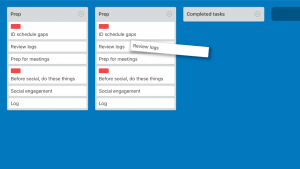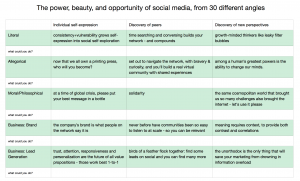It’s October 16th, 2017 and I’ve fallen deep into a blogging hole. After ten years of creating tons of opportunities by blogging – I have no excuse not to write up a quick post about the things on my mind more or less every day. So I’m going to do that for the next 30 days, through the middle of November. We’ll see how that feels.
In his book Return on Influence, marketing expert Mark Schaefer says there are two ways that consumers relate to “influencers” in any market. The first is as an authority to obey, because obeying authority generally serves most people well (?) and because it’s a big time saver over having to make all your decisions for yourself. I don’t know about that, I don’t like the sound of it, but I can respect the effort to save time and effort on non-essential decisions.
“…many people, overwhelmed by the information and the density of modern life, are conditioned to look for decision-making shortcuts ascribed to real or perceived indicators of authority. This fundamental psychological principle can lead to an autoresponse, and without extreme care and due diligence, that can be dangerous.” (Schaefer, 2012) [Ahem…Russian fake news…]
Another world is possible, though!Â
Earlier, Schaefer writes “Bloggers are passionate about what they do and are usually expert witnesses to developments in the industry. Their reputations are built on their ability to provide an insider, passionate, and balanced perspective because their reputation depends on it every day.”
This is a model where “influencers” bring expert knowledge, historical context, and broad perspective to a discussion online. That’s so much better for the human soul.
Influencer marketing as connecting to thought leaders who can put you and your company’s efforts in context. Like, “trust me, I’ve looked at all the products in this market and this one is super cool. I’ve been talking to the company for several months and I know where they are coming from and how it relates to competitors.” That’s good stuff.
From a marketer’s perspective, that might be understood as an influencer saying “I’m going to give you an independent opinion that puts this thing in context, validates it, and helps you make a more informed decision regarding whether or not to buy it.”
Back when I was the first writer hired at TechCrunch, founder Michael Arrington used to insist that every write-up of a technology include two things. 1. Information about the founding team’s backgrounds. And 2. some critical perspective on the company or product. I think that was Michael’s idea, the second one might have been mine, I can’t remember. But if you read a blog post about a product and there’s not a single critical word in it, then that’s just a small step above a press release.
Some people used to say “I don’t read TechCrunch for the writers’ stupid opinions, I just read that site because they find cool things first and I click the links.” I have always argued that having a thoughtful, researched, somewhat-informed stupid opinion can be a big value add and help any content creator rise above the others. That’s why I always tried to include in my blog posts about products some thoughts from other writers, mentions of competitors, and any other context I could.
Today, the broad spectrum of strategies available in influencer marketing includes not just connecting with people who will advocate for your brand or product – but who will help put it in context. Even more common, however, is the smart strategy of listening to influencers (not just listening for influencers) – because they can tell you a lot about what’s going on out in the market. Then you can use that information to maximize your relevance. The relevance of your marketing, of your product, of everything.
As marketing thought leader Jay Baer says, there are only two ways to win in marketing and communication these days: by being more emotional than others, or by being more relevant. “Relevancy is the killer app,” he says.
Hoping that influencers will drive people to make a decision because those people have an innate need to defer to authorities is kind of icky.
Spending time listening to and engaging with influencers so that you can better understand the context you’re going to market in – and they can help put your work in context for their readers/viewers/followers? That’s awesome.

